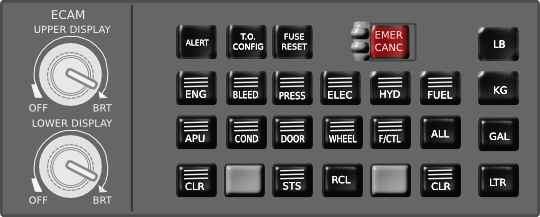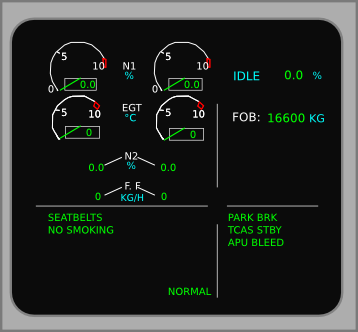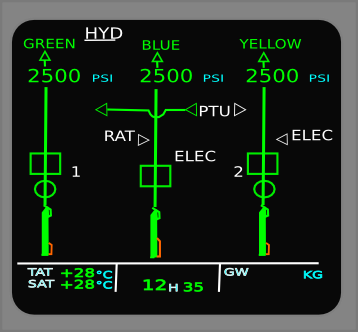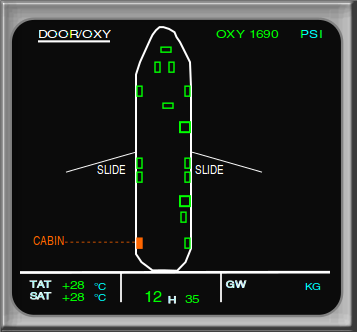Cockpit Inspection - ECAM Review
by Eric Bradley, 15 July 2015
You may recall that earlier it was mentioned that the preflight briefing doesn't necessarily mention every single bit of data you could possibly need to know about the state of the aircraft.
Fortunately there is a way to get some kind of idea if there are any really important things you should know about. To do this, you will need to go the ECAM control panel, which is located on the pedestal between the two MCDU devices. The illustration below shows what this looks like.

Drawing:
Eric Bradley
[© 2015]
This panel controls the display of information to the ECAM displays (there are 2 on the A320, upper and lower, located in the center of the forward panel). The upper ECAM display is used to show the most important system information that the pilots need to know.

Drawing:
Eric Bradley
[© 2015]
The top left quadrant shows gauges that indicate the percentage of max RPM (N1) for each engine, Engine Temperature (EGT) in Centigrade, percentage of max turbine power (N2) for each engine, and fuel flow to each engine. Any text that shows in cyan is something you can manually change, for example you could swap KG for LB if you have the ECAM model that includes conversion buttons.
The top right quadrant shows the thrust setting and percentage of power being delivered, and the total fuel on board. The lower left quadrant displays system status messages and warnings. And finally the lower right quadrant shows checklist items and memos. Depending on model, critical messages are shown in amber or red.
At the center of the bottom row of buttons on the ECAM panel there is a button marked "RCL" and what it does is if you press it in and hold it for 3 seconds it will show in the upper ECAM display all the cautions and warnings that were raised during the previous flight. Hopefully you won't see any at all, but it is good to know you can do this.
If you do see any warnings on the ECAM display, you will need to notify the maintenance crew and review the MEL to make sure you can still fly the jet safely. When there are no faults, the message "NORMAL" will appear on the ECAM for 5 seconds, as shown in the example below.

Drawing:
Eric Bradley
[© 2015]
It is important to understand that even though the screen shown above does display some engine information, it is not the same screen you would see if you pressed the ENG button. We'll get to that in a moment.
All of the buttons on the ECAM control panel that have horizontal lines on them correspond to a "page" that can be shown on the lower ECAM panel. Just to clarify a point, sometimes the upper ECAM panel may be referred to by some aviators as the Primary Engine Display and the lower ECAM panel may be called the Secondary Engine Display. These terms are not technically correct, but acceptable.
You may also hear ECAM referred to as EICAS. This is most definitely wrong, and is what happens when Boeing pilots transfer to the Airbus. They may still accidentally refer to Airbus systems using Boeing terminology.
It's acceptable as long as you know what the equivalent systems are between the two aircraft and also know the differences between them. Otherwise it can lead to confusion in the cockpit, which is potentially a very dangerous situation. Clear and accurate communication can make the difference between crash and no crash.
The next thing you will need to check is the hydraulics system. You want to know if the hydraulic fluid levels are sufficient. Press the HYD button on the ECAM control panel and a page similar to the illustration below should display on the lower ECAM display.

Drawing:
Eric Bradley
[© 2015]
The above image shows an unready hydraulics system. We will show you how to get the hydraulics ready in a later post about cold starting, so don't worry about that for the moment. When you receive the jet from a handover, the hydraulics should already be pressurized and ready to go, like this:

Drawing:
Eric Bradley
[© 2015]
If the hydraulics are looking healthy, you are ready to move on to the next step. Now you will want to press the ENG button on the ECAM control panel. This button is on the 2nd row on the left side of the panel. What you will be doing is looking at the oil levels and oil pressure and looking for any problems.

Drawing:
Eric Bradley
[© 2015]
If the engines have been off for a while then PSI should be at zero. It is perfectly acceptable for a value to show red if you are expecting it.
Finally, press the DOOR button (center row, between COND and WHEEL) and check the oxygen pressure level.

Drawing:
Eric Bradley
[© 2015]
IMPORTANT: You should use this site with Chrome or Chromium browser for best results because other browsers may have too many keyboard quirks that will quickly become annoying (for example, the QuickFind feature in Firefox, or the way Firefox uses the backspace key for navigation).
For most users, it will be best to switch the browser to full screen mode (F11), so that the screen won't scroll unintentionally.
REALLY IMPORTANT: This page requires a minimum viewport area of 900px wide by 600px high. It is NOT intended to be used on a smartphone or mobile phone display, but will work on tablets that meet the minimums. You will get best results with a PC running Chromium for Linux in full screen mode.
UPDATE: From August 2017 we fixed this problem slightly. It will now scale the entire screen on Android phones. Unfortunately if your phone has a very small screen, that may make it difficult to read the text.
In the lesson panel on the left side of the page, you will see it has been divided into 3 sections.
The top section shows the available lessons, displayed as a row of buttons. Each lesson is designed to follow from the previous one, so it is best to complete them in order from left to right.
The middle section is the lesson body, which contains all the content of the lesson.
If you see a green button, this means it leads to information that is essential for continuing (exception is on the preflight checks page, where color has no meaning). Blue buttons link to information that may be of interest, but is not essential.
The lesson body may need to be scrolled in order to see all of the content. It is important to remember that when moving between pages, on most browsers the scroll position will not be reset (if you know how to do that without refreshing the page, be sure to let us know). You will need to scroll back to the top yourself.
The bottom section divides the lesson body into pages, making it easy to go back and review what you have already read before.
Most of the time, you should read every page of every lesson. The exception is lesson 1: Check & Start. For that lesson, you can skip straight to page 5 if you have no interest in real-world aviation and only want to learn the MCDU procedures.
This help file is due to be updated and will be given a new separate page with much more detail.
For now, we felt it is better to just get the most vital information out there as quickly as possible, so you can started. We will make fixes as we go, and continue adding content as it becomes possible.
Our site is famous for two reasons... first and best, because of our attention to detail and our solid attempt to create the most realistic free online training tool available for the MCDU. But unfortunately we're also famous for how slowly we can make updates.
We'd like to improve on both counts! And that's where you have the opportunity to help.
This product is available to the public totally free of charge and we don't make any profit from it at all. We volunteer our spare time to work on the project and unfortunately there is less and less of this spare time available.
So we are now asking any enthusiastic volunteers who would like to see this project reach its full potential to assist with developing the project. It is really easy to help and you don't need to be a programmer to do it!
You can help us by adding new airports, waypoints, routes etc. If you can spare just one hour to help with that, even if you only add one line of data, it will go a long way towards getting this project up in the air :)
Everyone who helps will get a shiny new developer credit that you can display on your CV or brag about to your friends or whatever else you want to do with it.
Please use the email contact form to get in touch if you are interested. Also any active duty or trainee A320/A330 pilots (or similar) who would like to help in other ways than adding data, we are also very keen to talk with you!
My sincere thanks to everyone who has helped us to keep this project alive for another year, and I truly hope we can continue to make things even better.
xmodmap -e "pointer = 1 25 3 4 5 6 7 8 9"
When we first started this project, many airlines were still using the older MCDU hardware with just software updates, so many of them had a simple OFF/BRT knob that you rotated to adjust the brightness or turn the unit off. That is no longer the case and it is much more common to encounter the newer hardware, so we have implemented a long overdue update to the interface. Now you use the BRT and DIM keys to switch on and off. We have not added incremental brightness yet, but it is planned for the near future.
New
FANS
/ ATC COMM tutorial available!
Additional information is available from
document
or visit
IBAC website).
For now, it works in a much simplified manner. Tough break, but we need more money!
Fixed PERF CLB / CRZ / DES pages.
Built framework for PERF APPR page, but it does
not display yet (needs a little coding, thanks for
your patience and understanding).
Now also working on some new LATREV functionality.
Added section to website to allow you to
participate in developing this project.
For the moment, because I don't yet have any other place to bring this notice to attention, regarding the soon-to-be-implemented communications features, I would like to present this document containing potentially important information regarding the nature of communications messages and some of the matters that you should be aware of. Eventually we will get around to providing a tutorial on all this stuff here on the MCDU website. The features will be available before the tutorial is ready, so that is why I have made the link to the document, which is not a tutorial but does raise some important issues that will undoubtedly be of help to you in your training.